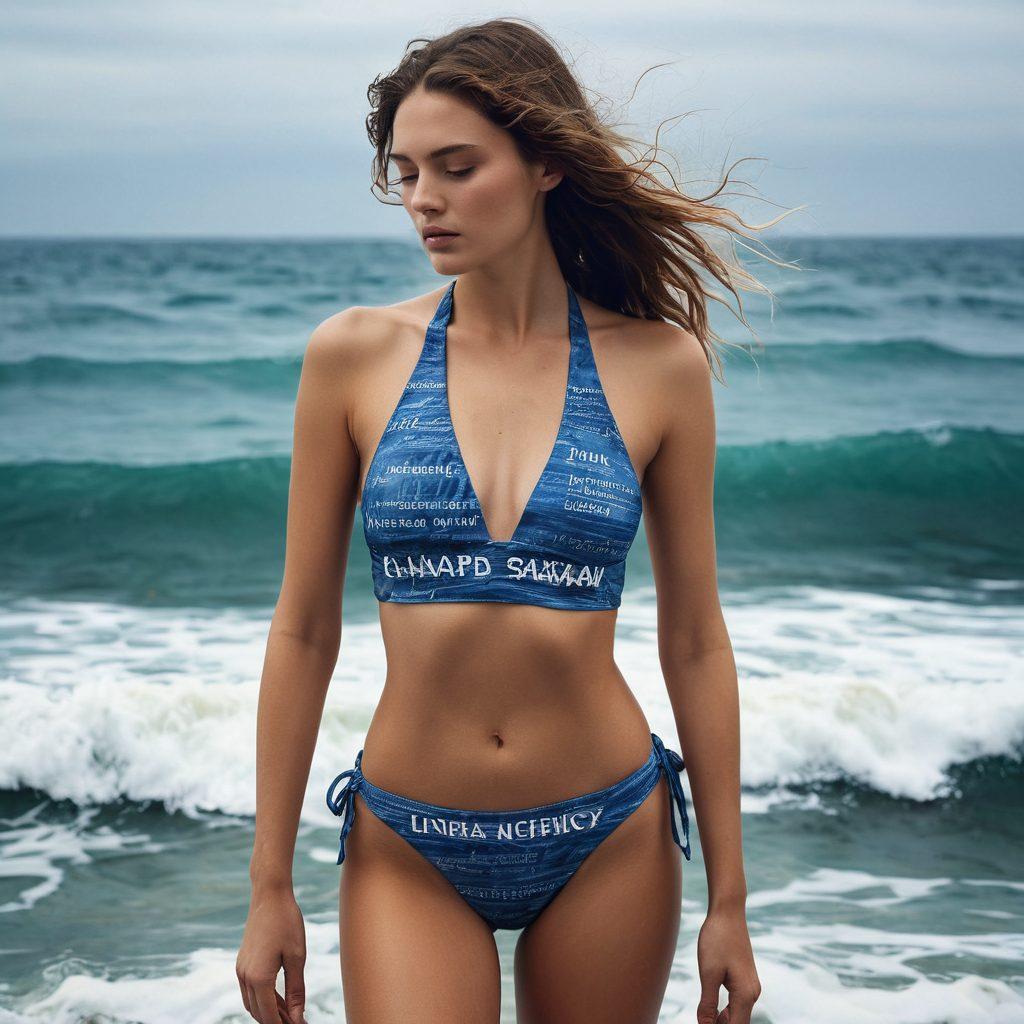Diving Deep: How Language and Swimwear Reflect Our Emotions of Sadness and Melancholy
In the grand theater of life, each of us has a role, and within that script, our emotions command the stage. What if I told you that the swimwear you choose can be a reflection of your inner emotional landscape, especially when grappling with feelings of sadness and sorrow? Just like in writing, where grammar and syntax guide meaning, our choices in beachwear can narrate the story of our emotional state. Have you noticed how some days you reach for a vibrant bathing suit while other days, a muted, darker hue seems more fitting? This duality is both intriguing and worthy of exploration as we unpack the grammar of grief concealed within our swimwear choices.
Have you ever considered that there might be a language to sadness, a grammar steeped in melancholy and unhappiness? Just like linguists analyze sentence structure and punctuation to derive meaning, we can delve into our decisions about swimwear with equal curiosity. Each time we slide into a bathing suit that reflects our mood, we are constructing a visual sentence that communicates emotions without uttering a single word. If swimwear could talk, what tales of sadness would it share? 'Look at me in this deep navy while I ponder my sorrow,' it might whisper, or 'I'm bold and bright today, masking my inner turmoil.'
The beach can often be touted as a symbol of joy, laughter, and sunny days, where the sound of waves washes away the weight of the world. But what happens when underlying depression casts a shadow over the shoreline? Choosing swimwear during these times can become a nuanced form of expression. A simple black tankini could represent a fortress to hide our melancholic thoughts, while a colorful bikini might signal an effort to rise above the feelings of despair. Examining the vocabulary of swimwear allows us to interpret these complex emotions through the lens of fashion. Do we dare to wear our emotions so boldly, or do we prefer to conceal them?
In the world of swimwear, the nuances of colors, patterns, and styles reveal more than just aesthetics; they speak volumes about our emotional states. For instance, floral prints may signify an attempt to embrace happiness, whereas darker shades can convey a struggle with stress. Those fabric choices are more than superficial; they’re indicative of our internal narrative. As we oscillate between various swimwear options, we engage in a profound conversation with ourselves. What if our beachwear choices could challenge the conventions of language rules, forcing us to confront our depths of emotion? How might our beachwear reflect the sadness we often try to hide?
Ultimately, the intersection of swimwear and sadness requires a deeper understanding of our emotions. Embracing the grammar of grief through our choices can forge a sense of connection and solidarity with others who share similar journeys. Next time you peruse a rack of bathing suits, consider how the colors and cuts resonate with your emotional narrative. Choosing swimwear can be more than just a summer decision; it can become an engaging dialogue between your heart and your wardrobe. Do you prefer to wear your emotions on your sleeve, or do you find solace in a more understated approach? In either case, stay attuned to your choices, for they may reveal the rich tapestry of human experience we all share.
Melancholy on the Beach: How Our Bathing Suits Communicate Unhappiness
When we think of the beach, we often envision vibrant sunsets, gentle waves, and joyous laughter. However, tucked beneath the surface of these sunny retreats lies a different narrative – one woven into the fabric of our swimwear. How can a simple bathing suit be a reflection of our deepest sorrows and feelings of unworthiness? This intriguing notion leads us to explore the concept of melancholy on the beach, where our choice of beachwear transcends its practical function and reveals a deeper emotional context. Just like the intricate rules of grammar and syntax create meaning in language, our swimwear choices, too, convey a rich tapestry of emotions, including sadness and unfulfilled desires. After all, swimwear isn’t just an outfit; it’s a statement of our inner self, a lexicon of our melancholy waiting to be interpreted.
Consider the colors and styles we gravitate towards when shopping for swimwear. A muted, dark-colored bathing suit might suggest a state of unhappiness, possibly reflecting our emotional battles with melancholy and depression. In a world where brighter hues symbolize joy and celebration, choosing to slip into a swimsuit draped in shades of gray or deep blue can feel like donning a cloak of sorrow. One might ask, "Why would someone intentionally wear something that mirrors their sadness?" Perhaps, just perhaps, it provides a sense of camaraderie with one's feelings, allowing us to embrace vulnerability even when we're surrounded by apparent happiness. It’s our way of saying to the universe, 'I’m here, and I’m feeling this.'
There's a powerful connection between language and emotions, much like the interplay of fashion and feelings. Writing beautifully involves a conscious arrangement of syntax and vocabulary, each word chosen and placed to evoke specific reactions. Similarly, our choice of beachwear communicates unspoken thoughts – the repressed sorrow trapped in our hearts. Have you ever noticed how people dress at the beach? Some radiate confidence with flamboyant patterns and loud colors, while others blend into the backdrop, their swimwear merely an extension of their subdued existence. It’s as if beachwear possesses a linguistic capability, speaking volumes about our state of mind through the whispers of fabric and design.
As we observe fellow beachgoers clad in their swimwear, let's reflect on the stories that might linger beneath their sun-soaked appearances. Someone wearing an oversized cover-up paired with a simple, dark swimsuit might be shielding their emotions more deeply than they appear. What if their unassuming attire is a silent acknowledgment of their struggles with sadness or sorrow? Just like writers craft sentences with punctuation to guide readers through their narrative, our bathing suits serve as punctuation marks in the narrative of our lives, emphasizing our profound feelings and experiences. Each piece, whether it’s a bikini or a one-piece, holds a narrative that goes beyond just fabric; they highlight emotional dialogues about fears, insecurities, and heartfelt desires.
Ultimately, swimwear is an arena where our emotions can blend seamlessly with our identity, allowing us to reflect on the melancholy that sometimes clouds our beach days. So the next time you find yourself slipping into your bathing suit, take a moment to consider what you’re communicating to the world. Are you flaunting colors that celebrate life or indicating a need for warmth and understanding through your choice of swimwear? Each trip to the beach could be an opportunity to practice self-expression and explore the intricate relationship between our swimwear and our emotions. It is a reminder that beneath the sun’s tempting rays, the beach can also be a space to acknowledge our inner journey, filled with both joy and sadness.
Dressed in Sorrow: The Emotional Syntax of Swimwear and Language
Imagine standing at the shoreline, the sun dipping below the horizon, casting long shadows across the sand. You pull on your favorite bathing suit, an ensemble that’s loaded with memories—from carefree days splashing in the surf to quiet moments of reflection. But what if I told you that this seemingly simple piece of swimwear could evoke emotions as complex as sadness and melancholy? Just as grammar lends structure to our writing, swimwear reflects our emotional states, unpacking layers of sorrow and unhappiness hidden beneath the surface of our lives. Dive in with me as we explore the emotional syntax of swimwear and language.
Language has its own set of rules, a grammatical structure that helps convey our innermost feelings. Language is like beachwear; it can offer a vibrant expression of our joys or a muted reflection of our sadness. Just as we carefully choose our vocabulary based on the context, our choice of swimwear can reveal our current emotional landscape. Are you opting for bright colors and bold patterns, or are you drawn to muted tones that align with your melancholy moods? Every choice tells a story, much like each sentence unfolds with its punctuation and syntax, assembling our thoughts into a coherent narrative.
Consider this intriguing question: How does a bright bathing suit make us feel more adventurous, while a simple, dark piece might evoke thoughts of sorrow? When we think of swimwear, we typically imagine fun-in-the-sun scenarios. However, what if that bathing suit you wear speaks volumes about your state of mind, echoing feelings of depression or unhappiness? A recent study suggested that certain colors can influence our emotions; perhaps our swimwear acts as a silent language, communicating what words often fail to express. Just like in linguistics, where the nuance of sentence structure can alter meaning, the elements of beachwear—its color, fit, and style—can encapsulate our emotional syntax.
In storytelling, we find clarity and connection, and this rings true in how we connect language and swimwear. Imagine walking along the beach in your favorite beachwear, yet feeling a heaviness in your heart. Maybe a family trauma haunts you, or perhaps a heartbreak lingers on your mind. Your bathing suit, once a symbol of carefree moments, now silently witnesses your sorrow. As writers, we use language rules to craft our narrative; as individuals, we choose our attire to navigate our emotional paths. Both converge at the beach—where the waves kiss the shore, and where introspection collides with the desire for escapism.
In conclusion, whether we’re weaving words into sentences or selecting swimwear for a day at the beach, emotions play an intrinsic role in shaping our experiences. Each bathing suit we wear and each word we speak serve as expressions of our internal worlds—sometimes light and playful, other times heavy with sadness and melancholy. So next time you slip into your beachwear, take a moment to reflect on what it says about your emotional state. After all, we are more than our sorrows, but they surely shape the syntax of our lives, both on the page and in the water.


